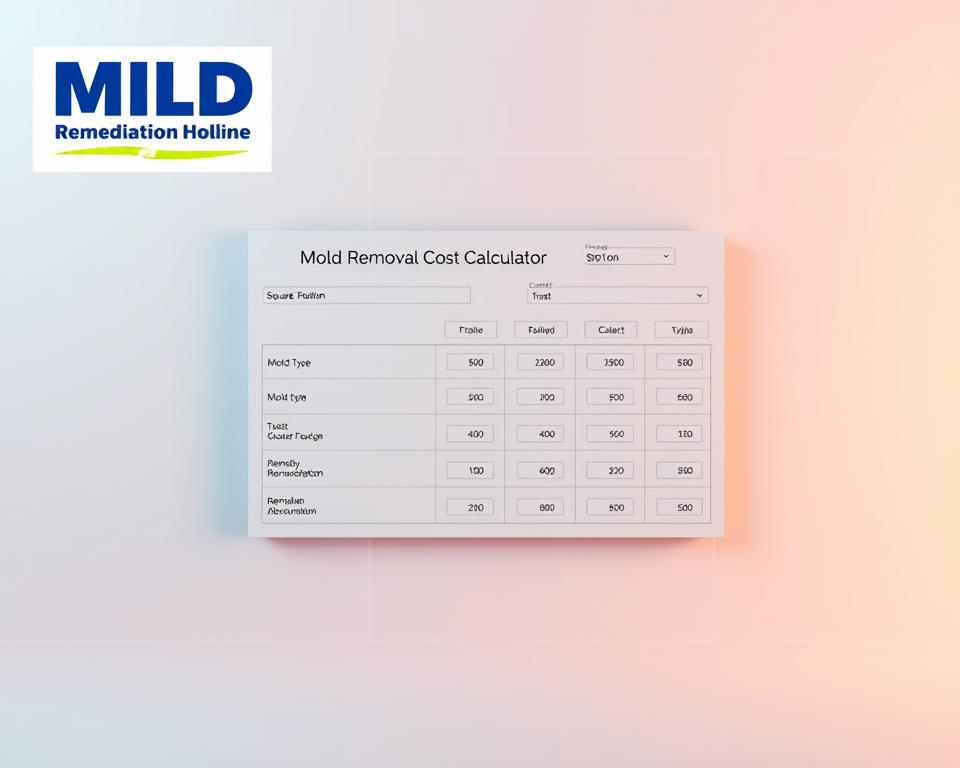Could your mold problem be draining your wallet more than necessary? Many homeowners underestimate how variables like square footage, regional labor rates, and cleanup methods impact their final bill. This guide breaks down how modern estimation tools create transparent, tailored projections for fungal remediation projects.
Specialized digital estimators analyze your unique situation. They factor in materials, containment needs, and even local disposal fees. For example, a 500-square-foot basement in Phoenix might cost $3,000 to treat, while the same job in New York City could reach $5,500.
These tools also clarify what professionals charge. You’ll see line items for air scrubbing, drywall replacement, or antifungal treatments. No more guessing why quotes vary between companies – the calculator reveals exactly where your money goes.
Key Takeaways
- Digital estimators provide customized pricing based on project scope and location
- Material expenses and labor rates significantly impact total costs
- Transparent breakdowns prevent overpayment for services
- Local regulations affect disposal and treatment requirements
- Understanding cost models helps compare contractor quotes effectively
Understanding Mold Removal and Remediation Costs
Home restoration projects involving biological growth often surprise owners with fluctuating price tags. Three primary elements dictate your final investment: physical space measurements, regional pricing trends, and material requirements.
Key Cost Factors and Restoration Needs
Treatment expenses typically follow per square foot calculations, with national averages ranging from $10-$25. Larger contaminated areas require more labor hours and specialized equipment. Hidden growth behind walls or under flooring often increases project complexity by 40-60%.
Project Scope and Conditions
Geographical location significantly alters pricing structures. Urban centers like Los Angeles show 22% higher labor rates than rural Midwest regions. Coastal properties frequently need antimicrobial treatments for humidity-related issues, adding $1.50-$3.00 per square foot.
Consider these critical variables:
- Structural materials needing replacement (drywall vs. concrete)
- Local disposal regulations for contaminated debris
- Air quality testing requirements post-treatment
Projects exceeding 100 square feet often trigger area-specific protocols mandated by state health departments. Always verify if your estimate includes both surface cleaning and deeper spore elimination techniques.
Accurate Mold Removal Cost Calculator in Action
Modern digital tools transform how property owners plan for fungal remediation projects. Advanced estimators eliminate guesswork by combining real-time pricing data with customizable inputs, creating tailored financial forecasts.
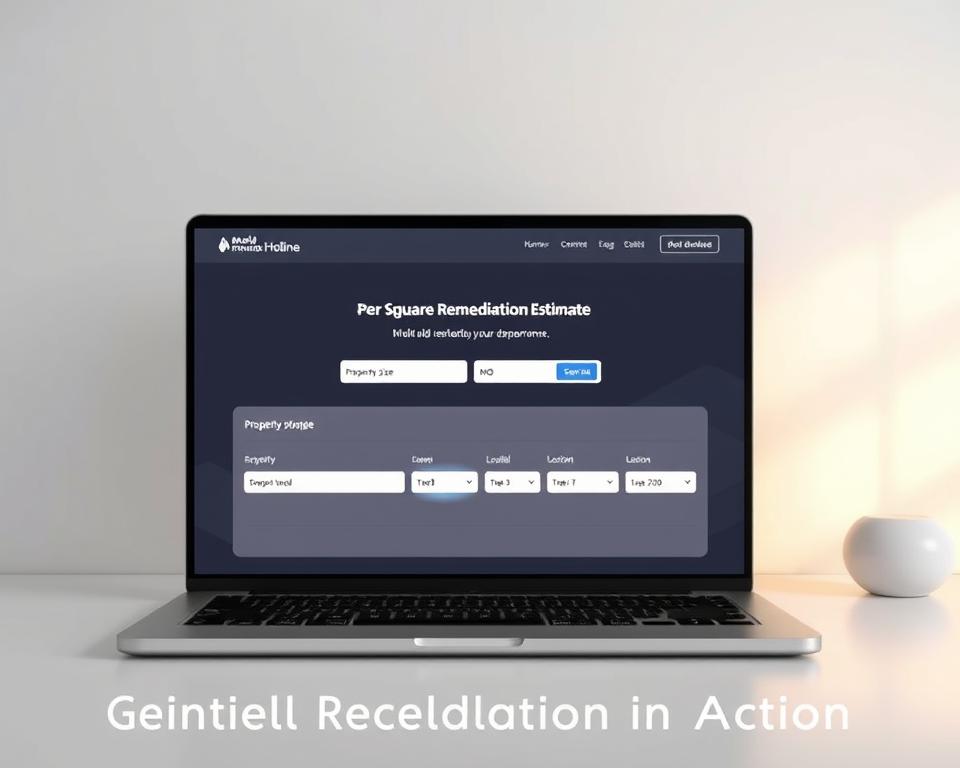
Calculator Features and Benefits
These platforms offer three game-changing advantages:
- Dynamic adjustments for material types and containment complexity
- Instant updates reflecting local labor rates and disposal regulations
- Side-by-side comparisons of different treatment approaches
Users report 30% fewer budget surprises when using tools with live market data integration. The system automatically factors in regional price variations, from Seattle’s higher wage standards to Texas’ competitive material costs.
How It Works for Your Project
Start by entering your space’s dimensions and contamination level. The algorithm processes:
- Affected area per square measurement
- Required protective gear and air filtration units
- Structural materials needing replacement
Within seconds, you’ll see a detailed breakdown separating labor fees from equipment rentals. Adjust your home’s square footage or treatment intensity to explore cost-saving options while maintaining safety standards.
Calculating Cost per Square Foot for Mold Removal
Property owners often grapple with unpredictable expenses when addressing fungal growth. Square footage serves as the cornerstone for creating transparent pricing structures in remediation work.
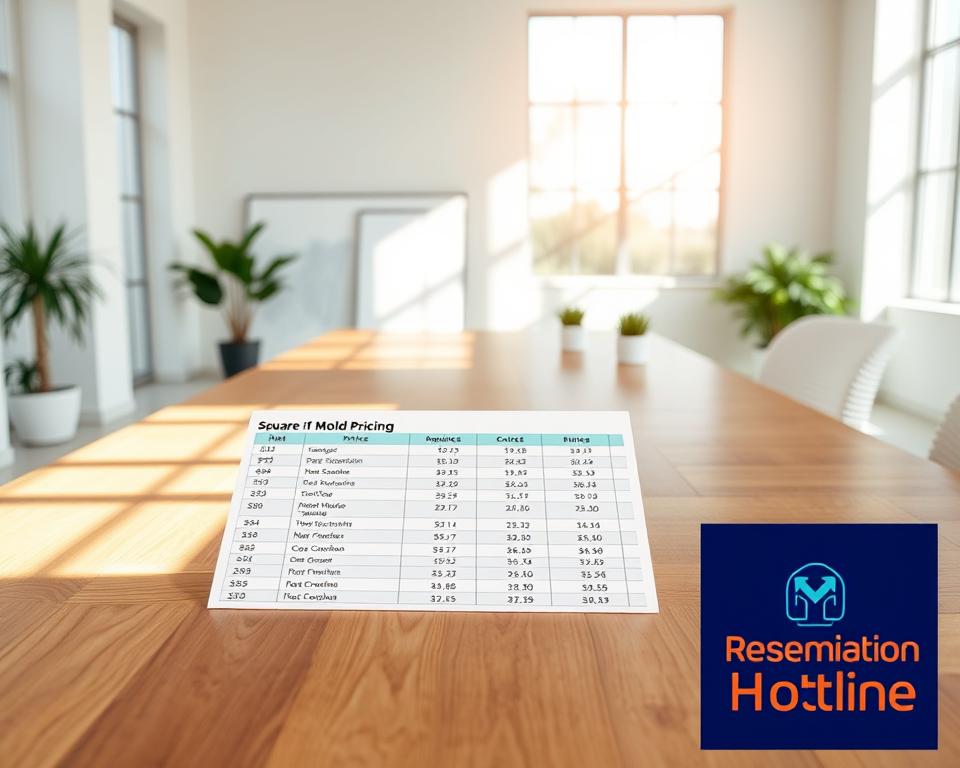
Square Footage Analysis and Pricing Models
Professionals develop pricing models using spatial measurements and contamination severity. Platforms like Homewyse show baseline rates of $1.50-$4.50 per square foot, adjusted for material porosity and spore penetration depth.
Total project expenses directly correlate with affected area size. A 200-square-foot bathroom may incur $800-$1,200 in fees, while a 1,000-square-foot basement often exceeds $5,000. These differences stem from equipment scaling and labor hours required.
Certified teams follow a systematic approach:
- Measure contaminated surfaces using infrared scanners
- Evaluate structural materials needing replacement
- Calculate labor based on regional wage standards
- Add specialized treatments for airborne spores
This methodology helps homeowners compare quotes effectively. Transparent breakdowns reveal why identical square footage might yield different totals across contractors – drywall replacement costs 35% more than concrete cleaning in most regions.
Understanding these calculations prevents budget overruns. Accurate spatial analysis allows for smarter negotiations with service providers, particularly when dealing with multi-room infestations requiring phased treatments.
Location, Project Size, and Unique Property Considerations
Your home’s blueprint plays a critical role in determining fungal treatment expenses. Geographic factors and structural nuances create cost variations that digital estimators now account for with precision.
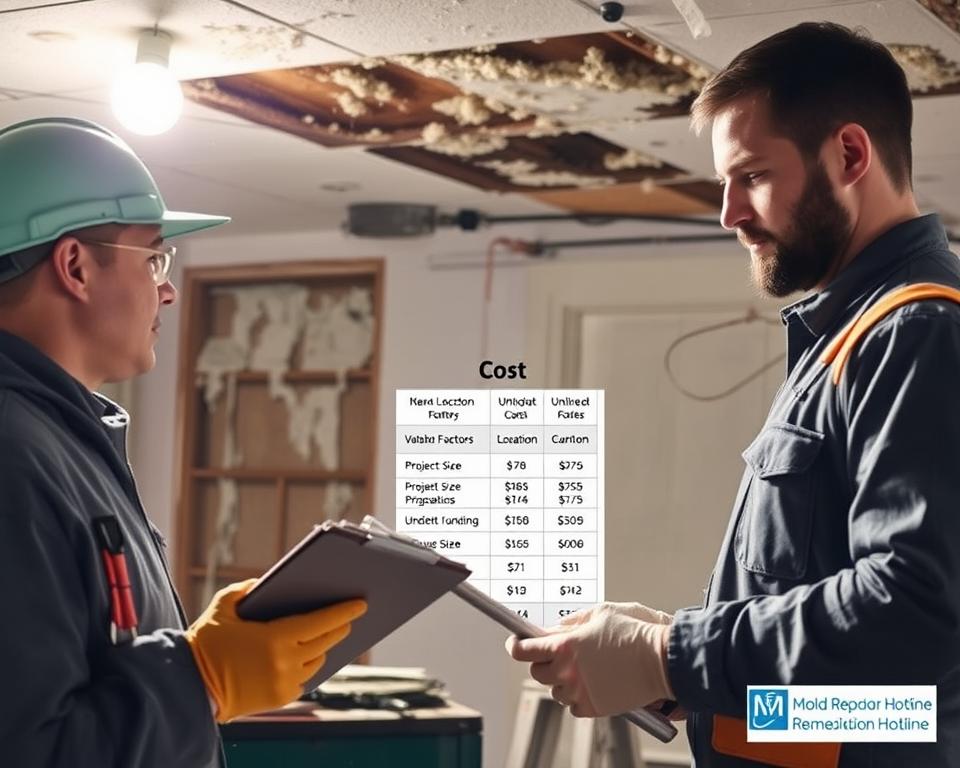
Zip Code Importance and Material Delivery
Entering your postal code ensures estimators account for regional pricing differences. Coastal regions often require moisture-resistant materials that cost 18-25% more than standard options. Urban centers like Chicago show 30% higher labor fees compared to rural Nebraska towns.
Delivery charges for antifungal treatments and protective gear fluctuate by distance. A contractor in Miami might pay $85 for bulk material transport, while a Phoenix team could spend $120 for the same shipment.
Area-Specific Challenges and Room Assessments
Basements and attics present distinct problems during remediation. Below-grade spaces often need sump pump installations ($400-$1,200) to prevent recurring issues. Attics require specialized insulation removal tools that add $3.50 per square foot.
Consider these room-based variables:
- Bathrooms needing tile resealing post-treatment
- Kitchens requiring appliance disconnection fees
- Historic homes demanding period-appropriate material replacements
Multi-level properties often incur 15% higher costs due to equipment staging challenges. A 1920s Craftsman home with plaster walls might need $2,800 in specialized cleaning, while a modern drywall construction could cost $1,900 for identical square footage.
Breakdown of Labor, Materials, and Equipment Expenses
Understanding where your money goes during fungal treatment requires peeling back the pricing layers. Three core elements drive project budgets: workforce hours, physical supplies, and specialized gear. Each component follows distinct pricing models that contractors itemize separately.
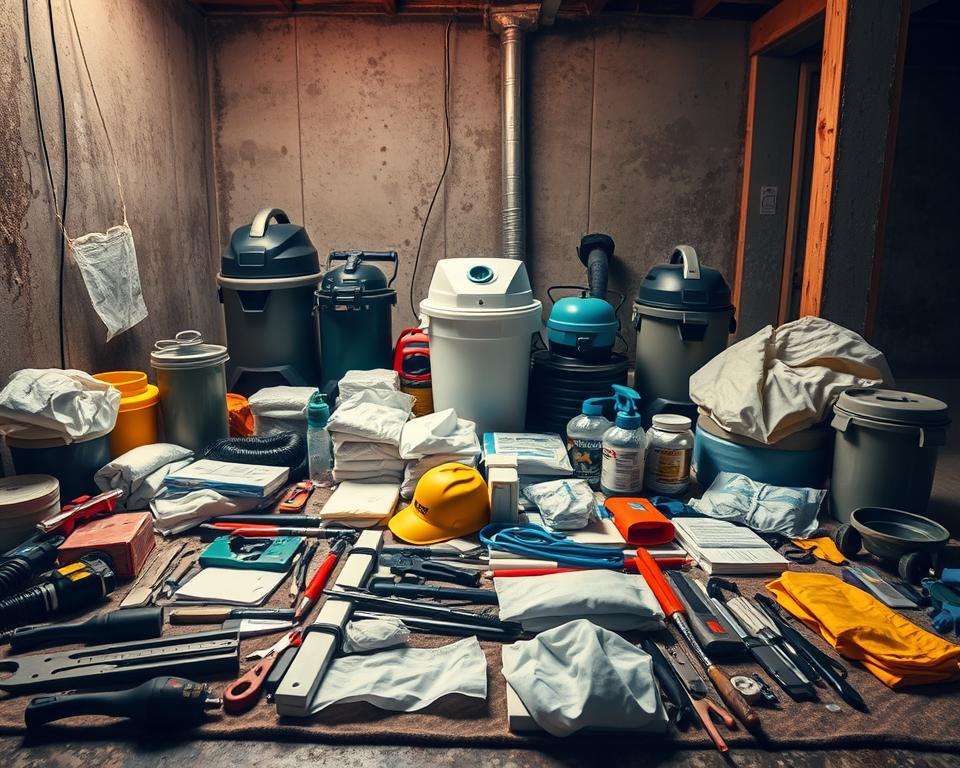
Understanding Individual Cost Components
Labor fees typically start at $45/hour per technician, with most companies enforcing 4-hour minimums. These minimums ensure teams can properly set up containment barriers and safety equipment. Crews often split time between basic removal work (45%), post-treatment cleanup (30%), and final inspections (25%).
Material costs vary by surface type. Porous materials like drywall demand more supplies:
- Antimicrobial sprays ($0.25-$0.75 per sq.ft.)
- Protective sheeting ($1.20 per linear foot)
- Replacement insulation ($2.80-$4.50 per panel)
Equipment rentals account for 18-22% of total estimates. Air scrubbers run $350-$600 daily, while moisture meters add $75-$150. Post-remediation inspections ($200-$450) verify all needs were addressed, using thermal cameras and air quality tests.
A 300-square-foot bathroom project might break down as:
- Labor: $1,080 (6 hours x 3 workers)
- Materials: $420 (sealants, sheeting, new grout)
- Equipment: $275 (HEPA vacuum rental, air monitors)
This transparency helps homeowners spot unnecessary charges. Always request line-item quotes to compare how contractors allocate resources across these key factors.
Understanding Mold Severity and Its Impact on Pricing
What appears as simple discoloration might signal costly structural compromises. Treatment expenses rise sharply when colonies penetrate building materials or produce harmful toxins. Professional assessments categorize growth into four classes, with Class 4 infestations requiring full containment protocols.
Common vs. Toxic Mold Considerations
Cladosporium and penicillium varieties typically cost $2-$4 per square foot to treat. Toxic black mold (Stachybotrys chartarum) demands specialized handling. Remediation teams charge 50-100% more for these cases due to:
- Advanced personal protective equipment requirements
- Mandatory airlock containment systems
- Medical-grade HEPA filtration needs
Urgency Fees and Additional Remediation Costs
Weekend callouts or same-day responses often add 15-30% premium pricing. Water damage from burst pipes accelerates spore spread, requiring simultaneous drying and antimicrobial treatments. A 300-square-foot basement with both issues could see costs jump from $1,800 to $3,400.
Three critical severity indicators affect budgets:
- Depth of material penetration (surface vs. structural)
- Airborne spore concentration levels
- Presence of sensitive occupants (children, immunocompromised)
Pro Tip: Always request spore identification testing before approving treatment plans. This $150-$300 investment prevents unnecessary expenses for non-toxic varieties.
Real-World Examples and Cost Variations
Regional challenges and property conditions create dramatic price swings in fungal treatment projects. Actual case studies reveal how geography and structural issues combine to shape budgets.
Case Studies and Regional Differences
A Tampa homeowner faced $8,400 in expenses after hurricane flooding caused widespread growth in their 1,200 sq.ft. ranch. Comparatively, a Phoenix condo with pipe leaks spent $3,200 for 600 sq.ft. treatment. These differences stem from:
| Location | Property Type | Key Factors | Total Cost |
|---|---|---|---|
| Florida Coast | Single-family home | Storm surge damage, drywall replacement | $12.75/sq.ft |
| Arizona Desert | High-rise condo | Low humidity, minimal structural repairs | $5.33/sq.ft |
| Midwest Suburb | Historic farmhouse | Plaster walls, lead paint containment | $18.40/sq.ft |
Impact of Water Damage and Restoration Needs
Flooding incidents typically double restoration requirements. A Houston kitchen remodel uncovered black growth behind cabinets – the extent of water infiltration added $2,100 in subfloor repairs. In contrast, Seattle homes with slow leaks often see 30% lower costs due to contained moisture.
Three critical restoration factors affect pricing:
- Immediate water extraction vs. long-term seepage
- Presence of porous materials requiring replacement
- Local code requirements for structural reinforcement
Projects combining water mitigation and fungal treatment average 45% higher costs than standard cleanups. Always verify if estimates include both emergency drying services and post-restoration air quality testing.
Choosing the Right Mold Removal Professionals
Selecting qualified experts for fungal issues requires careful vetting beyond price comparisons. Credentials, service guarantees, and regional expertise separate competent teams from unreliable contractors.
Evaluating Professional Estimates and Credentials
Always request three itemized quotes showing labor, materials, and testing fees. Certified specialists display IICRC or ACAC certifications – these ensure adherence to industry standards. Watch for vague line items like “miscellaneous supplies” that could hide markups.
Common issues when comparing proposals include:
- Varied measurement methods for affected areas
- Missing post-treatment air quality checks
- Undefined warranty periods
| Service Factor | Standard Inclusion | Red Flags |
|---|---|---|
| Containment Systems | Plastic sheeting, negative air pressure | No mention of isolation protocols |
| Disposal Methods | EPA-approved bags, tracked waste | “Local landfill” without details |
| Post-Job Verification | Third-party testing report | Self-certified clearance |
Tips for Hiring Locally in the United States
Regional licensing requirements impact service quality. Florida contractors need mold assessor licenses, while California requires CSLB certification. Ask these questions:
- How do you handle hidden growth behind walls?
- What’s your average response time for emergencies?
- Can you share before/after photos of similar projects?
Prioritize companies offering free retests if problems recur. For historic homes or commercial spaces, verify experience with your specific type of property. Cross-check online reviews with BBB ratings to spot consistent complaints about billing or incomplete work.
Conclusion
Informed decisions about fungal remediation start with recognizing how critical measurements and regional factors shape budgets. Modern estimation tools empower homeowners to forecast expenses by analyzing square footage, structural materials, and containment needs specific to their property.
Effective project planning hinges on three pillars: precise spatial assessments, advanced cleaning methods, and compliant safety systems. These elements determine whether you’re addressing surface-level issues or deep-seated contamination requiring specialized protocols.
Use digital estimators to compare labor rates and material costs in your zip code. Pair these insights with certified professionals who explain their cleaning processes and containment strategies. This dual approach ensures realistic budgets while maintaining air quality standards.
Remember – every successful remediation balances thorough systems for spore elimination with transparent financial planning. Leverage online resources and expert consultations to protect both your home’s integrity and your financial well-being.
